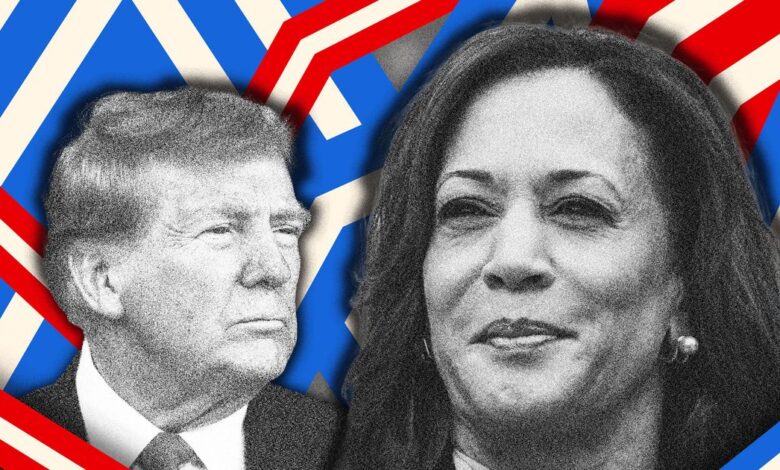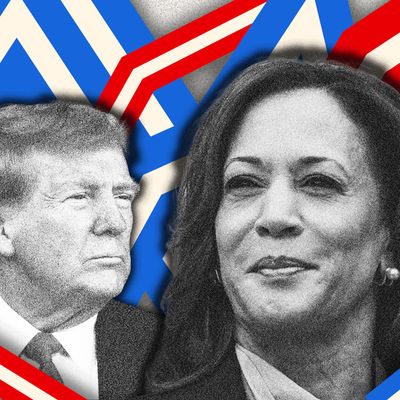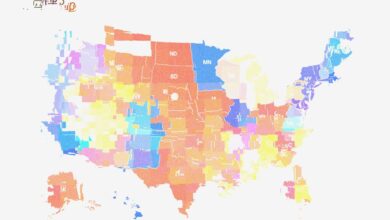

Photo-Illustration: Intelligencer; Photos: Getty Images
It’s been an exciting week for Kamala Harris. On Sunday, Joe Biden dropped out of the presidential race and endorsed his vice-president. In the ensuing days, she has quickly locked up the Democratic nomination as every potential rival endorsed her. And while it’s early yet, there’s now enough polling data to indicate that it’s a brand-new race — with Democrats obtaining some badly needed momentum and perhaps some new avenues for victory.
When Biden dropped out on July 21, he was trailing Donald Trump by 3.2 percent in the FiveThirtyEight polling averages and by 3.1 percent in the RealClearPolitics averages. FiveThirtyEight hasn’t posted averages with Harris, but RCP has her trailing Trump by 1.9 percent, and that’s with two outlierish polls from Rasmussen and Forbes-HarrisX giving Trump big leads (7 percent and 6 percent, respectively).
Perhaps more significant are the trend lines in major polls taken before and after the Biden-Harris switch.
On July 17, the Morning Consult tracking poll had Trump leading Biden by four points (46 percent to 42 percent). On July 24, the same poll had Harris leading Trump by a point (46 percent to 45 percent). On July 16, Reuters-Ipsos showed Trump ahead of Biden by two points (43 percent to 41 percent). On July 23, the same poll gave Harris a two-point lead (44 percent to 42 percent). On July 2, the New York Times–Siena showed Trump leading by six points (49 percent to 43 percent). On July 24, that pollster showed Trump leading by one point (48 percent to 47 percent). The only counter-indicator to those polls was NPR-Marist, in which Biden led by two points (50 percent to 48 percent) on July 11, while Trump led by one point (46 percent to 45 percent) in a one-day July 22 survey.
All of these polls show a close national race. Battleground-state data has been slower to arrive, but what we have shows Harris improving on Biden’s performance. A battery of Emerson–The Hill polls taken from July 22 to July 23 of five battleground states showed Wisconsin tied at 47 percent and Trump leading Harris by five points (49 percent to 44 percent) in Arizona, two points (48 percent to 46 percent) in Georgia, one point (46 percent to 45 percent), and two points (48 percent to 46 percent) in Pennsylvania. What’s more significant are the trend lines since the last polls from Emerson in mid-July, testing Biden against Trump:
A separate poll of Georgia from Landmark Communications also showed a close race there with Trump leading Harris by one point (48 percent to 47 percent). And a separate poll of Pennsylvania from NSOR–American Greatness showed Trump up by two points in that state (47 percent to 45 percent).
There is growing evidence that (as Democrats had hoped) Harris is doing significantly better than Biden among the young, Black, and Latino voting categories on which the Biden-Harris 2020 win depended. In the new Times-Siena poll, she leads Trump among under-30 likely voters by 59 percent to 38 percent, among Black likely voters by 72 percent to 19 percent, and among Latino likely voters by 60 percent to 36 percent. A new Axios–Generation Lab poll of 18-to-34-year-old voters showed Harris expanding a six-point Biden lead (53 percent to 47 percent) to 20 points (60 percent to 40 percent). All these trends could help Harris put Sun Belt states (particularly Georgia) back into play after Trump has held big leads for months.
In general, there’s a sense of momentum for Harris that may not last, but it has lifted Democratic spirits — and perhaps even reengaged an electorate unhappy with a Biden-Trump rematch (the new Times-Siena poll showed the number of “double haters” declining by more than half). It would be wise to stay very tuned for this contest.




